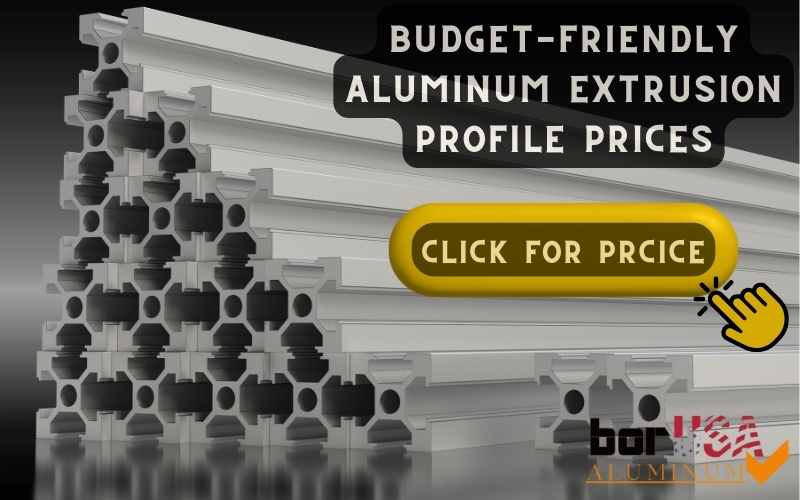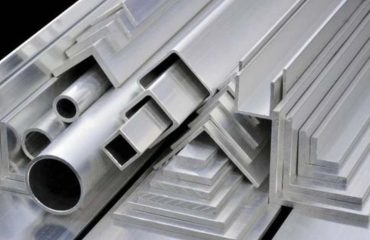Navigating the World of Aluminum Extrusion Profiles: A Comprehensive Overview
Aluminum extrusion profiles have become integral components in various industries, offering a versatile solution for designing and manufacturing a wide range of products. This comprehensive guide aims to delve into the intricacies of aluminum extrusion, exploring the fundamental processes involved and shedding light on the diverse applications that benefit from this versatile material.
From architectural structures to automotive components, aluminum extrusion profiles play a pivotal role in modern manufacturing, combining lightweight properties with exceptional strength and corrosion resistance. Join us on a journey through the world of aluminum extrusion as we unravel its applications across industries and highlight the key considerations for designing and utilizing extruded profiles effectively.
As Bor Aluminum we are one of the best American aluminum extrusion companies here. To learn the cost and price of aluminum extrusion profiles contact us.
Engineering Excellence: A Deep Dive into Aluminum Extrusion Profiles
Aluminum extrusion profiles exemplify engineering excellence through their unique combination of lightweight construction and exceptional strength. This manufacturing process involves forcing aluminum alloys through custom-designed dies to create complex shapes with precision and efficiency.
The resulting aluminum extrusion profiles have a consistent cross-section along their entire length and can be produced in a variety of shapes, such as T-shapes, I-beams, angles, channels, rods, and custom profiles. The profiles can be made with intricate designs, including holes, slots, and grooves, to meet specific functional requirements.
Aluminum extrusion profiles have numerous applications across various industries due to their unique properties. Here are some common uses:
Applications of Aluminium Extrusion Profiles in Lots of Different Industries

Aluminum extrusion profiles find extensive applications across various industries due to their versatility, strength, and other beneficial properties. Here are some specific applications in different sectors:
-
Construction Industry:
- Windows and Doors: Aluminium profiles are commonly used for window frames, door frames, and curtain walls in commercial and residential buildings. They offer durability, and corrosion resistance, and can be designed to accommodate different glazing options.
- Structural Framing: Aluminium extrusion profiles are used for structural components such as beams, columns, and trusses. They provide lightweight, yet strong solutions for building frameworks
-
Automotive Industry:
- Body Structures: Aluminium extrusion profiles are utilized for constructing body structures, such as vehicle frames and chassis components. Their lightweight nature contributes to improved fuel efficiency and performance.
- Heat Management: Aluminium profiles are employed for manufacturing heat sinks, radiator tubes, and cooling systems to manage the thermal requirements of various automotive components.
-
Electronics Industry:
- Heat Sinks: Aluminium extrusion profiles are widely used for heat sinks in electronic devices. They efficiently dissipate heat generated by electronic components, ensuring their proper functioning and longevity.
- Enclosures and Frames: Aluminium profiles are employed in the construction of enclosures and frames for electronic equipment, providing lightweight and durable solutions.
-
Transportation Industry:
- Railway Applications: Aluminium profiles are utilized in the manufacturing of railway carriages, including interior fittings, seating structures, and window frames. They offer lightweight and corrosion-resistant alternatives to traditional materials.
- Marine Applications: Aluminium extrusion profiles find applications in boat and shipbuilding for structures, masts, railings, and other components due to their resistance to corrosion in marine environments.
-
Industrial Machinery:
- Conveyor Systems: Aluminium profiles are commonly used to construct conveyor systems due to their lightweight and rigid properties. They provide a versatile platform for material handling in various industries.
- Equipment Frames: Aluminium extrusion profiles serve as frames for industrial machinery, providing structural support and flexibility in design.
-
Furniture Industry:
- Frames and Supports: Aluminium profiles are used for manufacturing furniture frames, such as chairs, tables, shelving systems, and display units. They offer lightweight, yet sturdy solutions with aesthetic appeal.
-
Renewable Energy:
- Solar Panel Mounting Systems: Aluminium profiles are employed for mounting solar panels on rooftops or in-ground installations. They offer a lightweight and corrosion-resistant framework for solar energy systems.
- Wind Turbine Components: Aluminium extrusion profiles find applications in manufacturing wind turbine components such as frames, supports, and housing due to their strength and durability.
These are just a few examples of the many applications of aluminum extrusion profiles in different industries. The versatility of these profiles allows for a wide range of designs and functionalities, making them a preferred choice across various sectors.
What are the Different Types of Aluminum Extrusion Profiles?

There are various types of aluminum extrusion profiles available, each with its own unique shape and design characteristics. Here are some commonly used types:
- Standard Shapes:
- Solid Bars: These profiles have a solid, uniform cross-section and are often used as structural elements or for general applications.
- Hollow Tubes: These profiles have an empty interior, making them lightweight and suitable for applications where weight reduction is important.
- Angles: These profiles have an L-shaped cross-section, with two perpendicular legs. They are commonly used for corner reinforcement, framing, and decorative purposes.
- Aluminum Channels: These profiles have a U-shaped or C-shaped cross-section and are frequently used for framing, edge protection, and sliding track applications.
- T-Slot Profiles: T-slot profiles feature a T-shaped slot along their length, allowing for easy assembly and connection of various components. They are commonly used in machine frames, workbenches, and modular systems where versatility and adjustability are important.
- Custom Profiles: Manufacturers can design and produce custom aluminium extrusion profiles based on specific requirements. Custom profiles can have unique shapes, dimensions, and features to meet specialized applications or design needs.
- Heat Sink Profiles: These profiles are specifically designed to efficiently dissipate heat from electronic components. They often have fins or other heat-dissipating features to maximize surface area and thermal performance.
- Curtain Wall Profiles: Curtain wall profiles are used in the construction of curtain wall systems, which are non-structural exterior building facades. These profiles are designed to support glazing panels and provide weather resistance.
- Decorative Profiles: Aluminium extrusion profiles can also be designed for decorative purposes, such as trims, moldings, or architectural accents. These profiles enhance the aesthetics of buildings, furniture, and other applications.
It’s important to note that the availability of specific profiles may vary among manufacturers. They can offer a wide range of standard profiles and also provide the option for customization to suit specific project requirements.
How to Choose the Right Aluminium Extrusion Profile for Your Needs?

Choosing the right aluminium extrusion profile for your needs involves considering several factors. Here are some key points to help guide your selection process:
- Application Requirements:
Understand the specific requirements of your application. Consider factors such as load-bearing capacity, structural integrity, thermal conductivity, corrosion resistance, electrical conductivity, and aesthetic considerations.
- Profile Shape and Design:
Determine the ideal shape and design of the profile based on the functionality and aesthetics you desire. Consider factors such as the dimensions, cross-sectional shape (e.g., solid, hollow, T-slot), and any specific features or customizations required.
- Material Selection:
While aluminium is commonly used, consider the specific alloy and temper suitable for your application. Different alloys offer varying properties such as strength, corrosion resistance, and machinability. Consult with aluminium suppliers or manufacturers to select the appropriate alloy for your needs.
- Quality and Certification:
Ensure that the aluminium extrusion profiles meet relevant quality standards and certifications, such as ISO 9001 or industry-specific certifications. This ensures that the profiles are manufactured to high standards and meet performance requirements.
- Supplier and Manufacturing Capabilities:
Choose a reputable supplier or manufacturer with expertise in aluminum extrusion. Consider factors such as their experience, production capabilities, customization options, lead times, and customer support.
- Cost Considerations:
Evaluate the cost-effectiveness of the selected profile, taking into account factors such as material costs, manufacturing complexity, finishing requirements, and long-term maintenance expenses.
- Sustainability:
If sustainability is a priority, consider the recyclability of the chosen aluminum extrusion profiles. Aluminum is highly recyclable, and selecting profiles made from recycled aluminum can contribute to environmental sustainability.
- Samples and Prototypes:
If possible, request samples or prototypes of the desired profiles to assess their suitability for your specific needs. This can help verify dimensions, functionality, and aesthetic compatibility.
- Collaboration and Expert Advice:
Consult with experts, engineers, or manufacturers who have experience with aluminum extrusion profiles. They can provide valuable insights, and recommendations, and help you make an informed decision based on your requirements.
By considering these factors and seeking expert guidance, you can choose the right aluminum extrusion profile that aligns with your application needs, performance expectations, and budgetary considerations.
Budget-Friendly Aluminum Extrusion Profile Prices
In conclusion, opting for budget-friendly aluminum extrusion profile prices opens up a realm of possibilities for cost-effective solutions across various industries. The affordability of these profiles does not compromise on quality, as advancements in manufacturing techniques ensure that cost-effective options maintain the desired strength, precision, and durability. Contact us to get advantageous aluminum extrusion profile prices and costs.

Bor Aluminum – Content Producer















